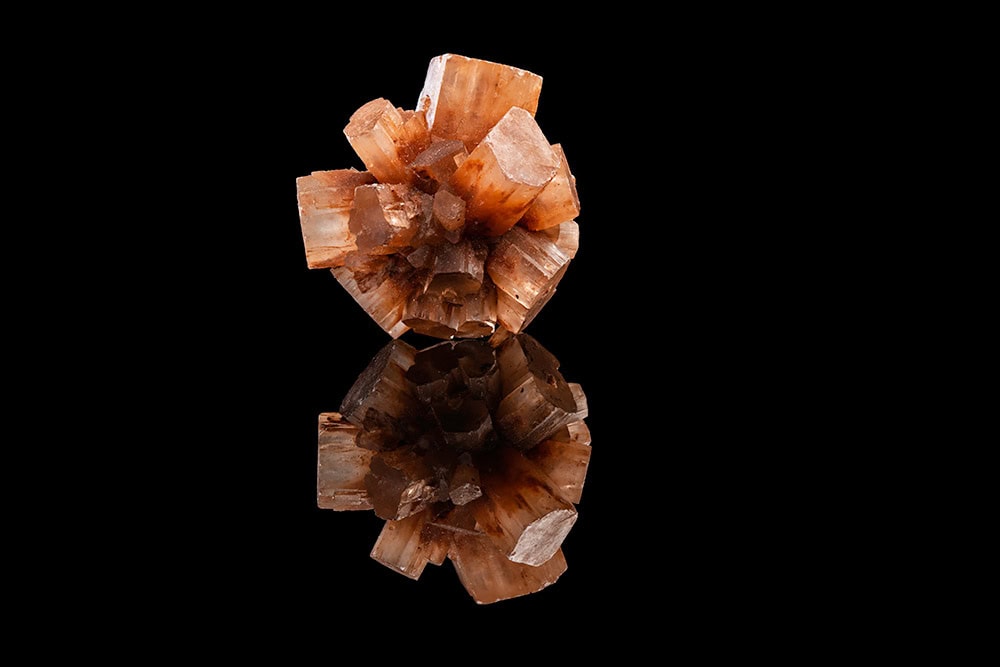
[Image above] A combination of the bacteria Sporosarcina pasteurii and urea triggers crystallization of calcium carbonate in its aragonite form. Credit: J. Adam Fenster, University of Rochester
In a few weeks, beaches across the United States will reopen for the season during Memorial Day weekend. And as some people flood to the beaches for swimming, surfing, and tanning, others will come to participate in annual beach cleanups.
Regardless of why you go to the beach, you will likely at some point stop to appreciate the pretty shells lying scattered on the sand. (Remember only to look, not take!) If one shell appears particularly shiny, you can probably thank nacre for its luster.
Nacre, also known as mother of pearl, is a natural organic-inorganic composite best known as the material that gives certain mollusc shells and pearls their lustrous shine. Nacre consists almost entirely (~95 wt%) of calcium carbonate (CaCO3) in its aragonite form. But nacre behaves quite differently from brittle monolithic aragonite, due to what makes up its other 5 wt%—a complex organic matrix of biopolymers such as β-chitin, lustrin, and silk-like proteins. This organic matrix drastically improves the toughness of nacre—it is up to 1,000 times tougher than pure aragonite crystal!

There’s a lot more to nacre than just shiny shells! Credit: Pixabay
Scientists have looked into creating synthetic materials that mimic nacre’s natural toughness, but many of the production methods involve high temperatures, high pressures, and/or use of toxic organic solvents.
“Many people creating artificial nacre use polymer layers that are only soluble in nonaqueous solutions, an organic solvent, and then they have this giant bucket of waste at the end of the procedure that has to be disposed of,” says Anne Meyer, an associate professor of biology at the University of Rochester, in a University of Rochester press release.
Meyer and her colleagues from the Netherlands, Italy, Switzerland, and Israel decided to look for a new way to synthesize nacre, a method that would be cost-effective and environmentally friendly. And the method they developed, as described in a recently published paper, rests on an innovative component that has also helped develop self-healing concrete—bacteria!
“One key advantage of our method of bioinspired materials production is that it is performed exclusively with bacteria: under ambient conditions, using only ecologically friendly and renewable components, and without producing toxic waste,” the researchers explain in the paper.
To create their nacre, the researchers placed a glass or plastic slide in a beaker containing the bacteria Sporosarcina pasteurii and urea, the waste product excreted by our kidneys (and major component of urine). S. pasteurii produces the enzyme urease, and this enzyme cleaves urea into ammonia and carbonate ions. The ion separation increases the solution’s pH, causing precipitation of calcium carbonate.
(In November, we reported on another team of researchers who also used S. pasteurii to create calcium carbonate, in order to bind sand into a brick.)
The researchers then used the bacteria Bacillus licheniformis to produce the anionic polymer polyglycolide (PGA), which they used as the organic matrix between CaCO3 layers. Through an iterative process of alternatively dipping the slides into S. pasteurii and PGA solutions, the researchers built up a layered composite approximately 200-µm thick (each CaCO3 and polymer layer was about 5-µm thick).

Alternating thin layers of CaCO3 and polymer, each about 5-µm thick, formed a cost-effective and environmentally-friendly synthetic nacre. Credit: J. Adam Fenster, University of Rochester
Though Meyer and her colleagues are looking for ways to speed up the process (it takes about a day to build up a single layer), there are enormous opportunities for application of their nacre. For example, their nacre could serve as a material for artificial bones (because it is biocompatible) and as building material on the moon (moon dust contains a lot of calcium, so an astronaut would just need to bring bacteria and *ahem* make the urea).
Curious to see their environmentally-friendly nacre-making process in action? Today’s video, produced by the University of Rochester, gives you a look at the process that may one day help build houses on the moon!
The open-access paper, published in Small, is “Bacterially produced, nacre-inspired composite materials” (DOI: 10.1002/smll.201805312)

Credit: University of Rochester, YouTube
Author
Lisa McDonald
CTT Categories
- Biomaterials & Medical
- Environment
- Material Innovations


